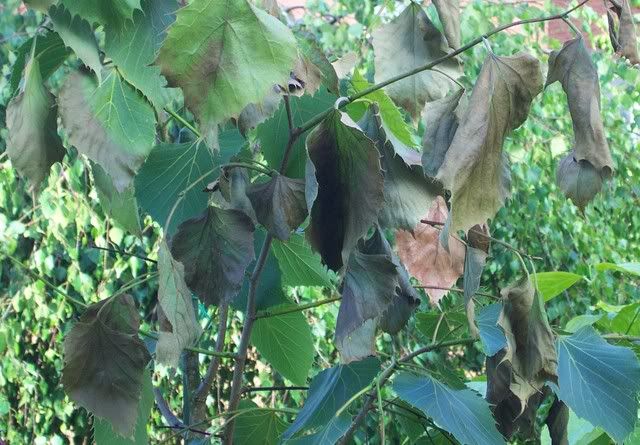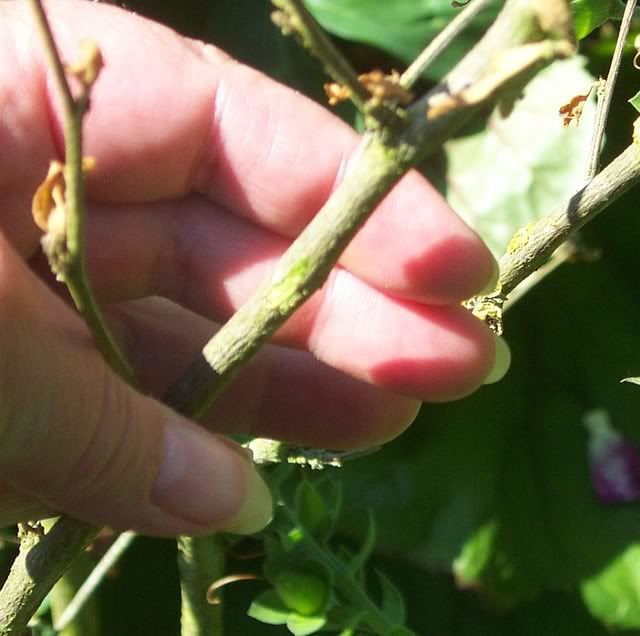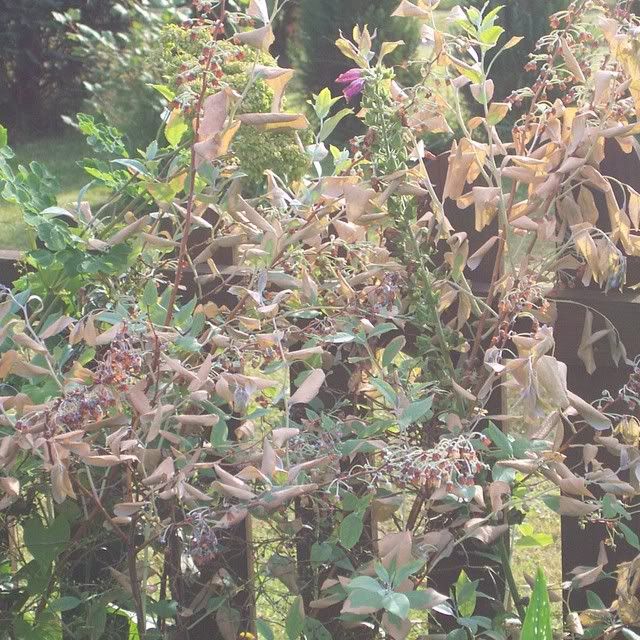|
|
Post by Rosefriend on Jun 24, 2008 11:45:22 GMT
Can someone please tell me what is wrong with my Linde (Tilia henryana) - I really am a little worried - this tree is/was beautiful. It had problems with the last bit of frost but after that was cut off it came back well - and now this. It is obviously some kind of fungus I should think - but what?   RF |
|
|
|
Post by Weeterrier on Jun 24, 2008 13:46:44 GMT
That looks awful RF, but I have no advice this time. How are the branches looking? Have you scraped the bark to look at the stems? If they look alright, I'd take off all the leaves, water and feed.
How is your Hibiscus doing?
|
|
|
|
Post by Rosefriend on Jun 24, 2008 14:12:42 GMT
The main stem of the Linde is still good - it is the new stems from this year, they are all dying back. I honestly don't know what it is. I thought to start with that my next door neighbour had been using weedkiller and perhaps some had got onto the tree but that isn't it , I don't think. It is getting worse and worse. As for the Hibiscus - well all the leaves have dried up completely now and are brown but a little scratch show that there is still juice there.. at least something positive.  RF |
|
|
|
Post by Weeterrier on Jun 24, 2008 16:44:36 GMT
Where there's juice, there's life RF  Hope someone comes up with an answer. What about trying the RHS? Think they answer questions like this. Or could you post on the BBC clinic board? |
|
|
|
Post by Rosefriend on Jun 24, 2008 17:06:29 GMT
I was thinking of the RHS - can you just E-mail them? I have to find out what it is and if I can stop it. The tree is 3 years old this year so it hasn't just been planted.
RF
|
|
|
|
Post by Weeterrier on Jun 24, 2008 17:15:55 GMT
I've looked it up for you, but it seems that the service is only for members. Perhaps Chuckles could do it for you? Go to the site, and browse. They have problem solving pages, you might even recognise something.
|
|
|
|
Post by Chuckles on Jun 24, 2008 17:18:50 GMT
OMG that don't look good RF  If you hadn't suggested fungus I'd have said it looked like frost damage but then you've not had any frosts  and I'm no expert on plant problems. The non effected leaves look so healthy too, hope you get and answer on here or via the RHS. |
|
|
|
Post by Chuckles on Jun 24, 2008 17:21:28 GMT
I've looked it up for you, but it seems that the service is only for members. Perhaps Chuckles could do it for you? Go to the site, and browse. They have problem solving pages, you might even recognise something. Yep I'm a member, let me know what you want me to do RF and I'll help wherever I can  good thinking Wee. |
|
|
|
Post by Rosefriend on Jun 24, 2008 17:29:19 GMT
As Wee says it is only for members - can you copy the pics and perhaps ask the RHS what it could be please.
The tree is 3 years old (I have had it 3 years) and it has been bud grafted. The frost did get it but I cut everything off and new shoots came and it was wonderful - this has happened within a week. I thought it could be the sun, weedkiller and the dreaded lurgy but I don't know what to do. All the young shoots are dying. Do I cut everything off - spray it and if yes with what or give it the last rites??
RF
|
|
|
|
Post by Chuckles on Jun 24, 2008 18:08:43 GMT
Consider it done RF  |
|
|
|
Post by Rosefriend on Jun 24, 2008 18:10:53 GMT
Marvellous Chuckles - thanks so much.
I have also sent an E-mail to the nursery where I bought it from - perhaps he has some ideas as well.
RF
|
|
|
|
Post by Amo on Jun 24, 2008 18:27:43 GMT
Looks like you have all bases covered there, I'll crossing everything for you here!!! I'm sure RHS will come up with something, they usually do.
|
|
|
|
Post by Chuckles on Jun 26, 2008 17:26:41 GMT
Well the RHS read the e.mail I sent on Tuesday yesterday morning at 8.30am so it will be interesting to see how long it takes them to reply  |
|
|
|
Post by Rosefriend on Jun 26, 2008 17:29:45 GMT
Thanks a lot Chuckles - I hope someone answers soon - another couple of stems have started and I an seriously thinking of digging it up....
RF
|
|
|
|
Post by Tig on Jun 26, 2008 18:44:41 GMT
I don't know if you will find anything useful here in the interim RF  web1.msue.msu.edu/imp/modzz/00001464.html web1.msue.msu.edu/imp/modzz/00001464.htmlAlso found this relating to Tilia quote "Verticillium wilt causes dieback and death of individual branches or the entire tree. Keep trees healthy to prevent the disease. Fertilizing infected trees with high nitrogen fertilizers helps." x Tig |
|
|
|
Post by Rosefriend on Jun 27, 2008 4:29:53 GMT
Thanks Tig - I have cut all the infected wood off and will feed it today and water it well.
I can only keep my fingers crossed - it is a wonderful tree - well it was - I do hope it survives.
RF
|
|
|
|
Post by Weeterrier on Jun 27, 2008 8:25:31 GMT
Who needs the RHS when there is Tig? Well done that girl. ;D
|
|
|
|
Post by Rosefriend on Jun 30, 2008 13:32:40 GMT
I have just got an E-mail from the Nursery where I bought the tree and he got in touch with a couple of his gardening buddies and the opinions are..
a) - die - back (well yes...)
b) - too much fertilizer (nope - fed it a little in March, not since)
c) - could be a fungus - but what??
d) - keep it watered and PRAY!!
The last sentence was - don't worry if you lose it - I have a couple more where that came from.....just as well that I know him isn't it.
RF
|
|
|
|
Post by Chuckles on Jul 4, 2008 19:24:00 GMT
Had a reply from the RHS today  Thank you for your enquiry to the Royal Horticultural Society's Members’ Advisory Service. Thank you for your enquiry to the Royal Horticultural Society's Members’ Advisory Service.
Your Tilia photographs show typical signs of leaf scorch (see attached leaflet). This is a non-specific sign of plant distress and it is impossible to ascertain the cause of this from photographs alone.
Because the plant is only 3 years old, it is still vulnerable to establishment problems (see attached leaflet). Try optimising the growing conditions as per the recommendations on the leaflets, drought and waterlogging being common causes of leaf scorch in new plants, and check the tree was planted according to recommendations on our attached tree planting leaflet.
If no improvement is seen, then we will need to see root and branch samples to look for possible root disease.
I hope this information is helpful.
You might be interested to know we offer several forms of self-help on our website for a wide variety of common problems and requests (see below).
Yours sincerely,
Maya Albert
Horticultural AdvisorThe Royal Horticultural Society Horticultural Advisory Services July 2003 Leaf Scorch of Trees and Shrubs and Chlorosis: Induced by Cold Weather or Waterlogged Soils Leaf scorch ........This is a common problem of maples (Acer species), beeches and occasionally other soft-leaved woody plants, especially those with golden or variegated foliage. The leaves of an affected tree or shrub begin to turn brown, particularly around the margins, then curl and shrivel, especially at the tips, giving a scorched appearance. Occasionally premature leaf fall may occur and a second crop of leaves is then produced later in the season. An affected Acer may also show some slight signs of dieback and the twigs may become dry and whitish in colour towards the tips. This disorder is primarily caused by cold winds and/or frost on the soft tissues so the symptoms are usually seen quite early in the growing season. It is more likely to occur on plants which are lacking in vigour or are suffering from dry soil conditions at the time. Sometimes, however, scorch can be caused by hot sun striking the leaves and in this case the symptoms may not be seen until later in the season. Any adverse factor which leads to lack of vigour in woody plants, such as soil conditions that are too wet or too dry, malnutrition, planting in an exposed position or even bad planting in the first instance, will tend to make them prone to leaf scorch. Golden-leaved or variegated plants are particularly susceptible because their foliage is inclined to be weaker than those with dark green leaves. Prevention. Once scorch has appeared, there is very little than can be done that season to help the plant. It is therefore essential to prevent the problem from recurring. If a plant has been affected regularly every year and the symptoms occur fairly early in the growing season, it may be growing in an exposed position where it is easily injured by cold winds or frost, in which case it should be moved to a more sheltered spot. Variegated cultivars may benefit from moving to a shadier site. Consider erecting a temporary wind shelter until newly planted trees and shrubs are established. Alternatively, use tough plants to shelter susceptible ones. Much can be done to prevent leaf scorch by seeing that the tree or shrub is well cared for. Plant it in well-prepared soil, making sure that the roots are well spread out and that they are not planted too deeply. The plant should then be mulched well with shredded bark or leafmould to conserve moisture and in dry periods it should be watered before the soil dries out completely. It is also essential to avoid waterlogging by improving drainage before planting. If the soil is kept reasonably moist at all times scorch is not likely to develop even in a season when there are great extremes in temperature. Trees and shrubs may benefit from an annual feed in February. General purpose fertilizers such as Vitax Q4 and Growmore are ideal for this purpose. Spread the fertilizer from 30 cm (1ft) around the trunk to 30 cm (1ft) beyond the outermost spread of the branches, to sustain actively feeding roots. If plants are growing in grass, small pieces of turf should be lifted at intervals around the tree and the fertiliser should be placed in each hole before the turf is firmed back. Where possible remove vegetation growing for at least a metre around trees and as far as the spread of branches of shrubs. Apply a thick 7.5cm (3ins) mulch of organic matter, after applying fertilizer, All fertilisers should be applied at the rate indicated by the manufacturer. Over feeding at the wrong time of year can also cause leaf scorch. If the symptoms of scorch have been severe with, perhaps, some premature defoliation, the plant may benefit from an application of a foliar feed. Nutrients applied in this way are taken in quickly by the leaves, promote vigour and encourage the development of new roots. If necessary a wetting agent such as soft soap, or a few drops of a mild liquid detergent can be added to the solution to aid adhesion to the foliage. Chlorosis Cold-induced chlorosis is common in spring on young, actively growing leaves, during particularly cold spells of weather. It occurs frequently on young magnolia leaves which become very pale or almost white. Leaves so affected remain in this condition for the rest of the season and there is no treatment which can be carried out to restore the green colour of the foliage. Skimmia and pieris are also susceptible to cold induced chlorosis. Yellowing of leaves or parts of leaves can occur as a result of waterlogged soil conditions; yews and Narcissus are particularly susceptible to this type of injury. It may be possible to improve the condition of the plants by spraying with a foliar feed, as above. Let soils dry out and wait until May before assuming chlorosis is due to lack of nutrients or disease. |
|
|
|
Post by Rosefriend on Jul 5, 2008 6:44:11 GMT
Well thanks again Chuckles and thanks RHS .....it looks as though I am going to end up with the main stem and nothing else....it really does look awful.
I personally feel that the winter will possibly give it the rest as it isn't slowing down - it is affecting the whole tree now.
What a shame - it was a fantastic tree.
RF
|
|
|
|
Post by Rosefriend on Jul 5, 2008 16:58:02 GMT
Well I must admit that I am a little upset - my Zenobia pulverulenta "Blue Sky" which was a dream this year now looks like this..  and guess what it is next to my Henry Linde...it makes me wonder what exactly is wrong with them all - my Hibiscus is now totally bare. RF |
|
|
|
Post by Chuckles on Jul 15, 2008 11:47:35 GMT
 I could cry for you RF it's terrible to see this sort of thing happen and have no real control. Hope they survive for you 
|
|
|
|
Post by Rosefriend on Jul 16, 2008 12:59:46 GMT
I could cry myself Chuckles - 3 of my best shrubs/trees in the garden. If we get a mild winter there's maybe a chance but I think they are far to weak to stand up to a really hard winter.
RF
|
|
|
|
Post by Rosefriend on Oct 14, 2008 13:20:07 GMT
Well my Henry Linde has bitten the dust - I only really rested my hand on it and it snapped off at the base - it is totally dry - what does that then - heaven knows we have had enough rain this year. Even the roots were dry. I had so hoped that it would make it.  The Hibiscus is coming back from the bottom but the first heavy frost will finish that off - I think I can forget this as well.  My Zenobia pulverulenta "Blue Sky" has bounced back which is a surprise.  and the 4th victim (the Laurel) is just waiting to be dug out.  RF |
|
|
|
Post by Amo on Oct 14, 2008 14:16:03 GMT
All a bit sad there RF!!!
Still, gives you a place to plant something new! Always look on these things as an opportunity.
|
|
|
|
Post by Barbara on Oct 14, 2008 15:56:34 GMT
can you see any type of parasite RF,? what a shame, but as amo says upwards and onwards with something new, always assuming you can plant in that spot,  |
|
|
|
Post by Rosefriend on Oct 15, 2008 11:27:24 GMT
Well the one thing that is upsetting/annoying me is that I don't know what killed them off in the first place.
I am thinking of putting my minarette apple trees in where the Linde and the Laurel were (banana plant won't fit after all) but I don't want to lose those as well.
RF
|
|
|
|
Post by Ruthie on Oct 15, 2008 19:39:25 GMT
It may be worth checking for honey fungus RF. Sorry can't do links but if you google it you should get loads of info on what to look for.
|
|
|
|
Post by Chuckles on Oct 15, 2008 20:32:39 GMT
|
|
|
|
Post by Rosefriend on Oct 17, 2008 15:14:44 GMT
It may be worth checking for honey fungus RF. Sorry can't do links but if you google it you should get loads of info on what to look for. I have just read through an explanation of Honey Fungus .....ooo not the nicest of things to have is it. My gut says that it isn't that which I am afraid still doesn't bring me any nearer knowing what it actually was. Thanks for the suggestion though. RF |
|